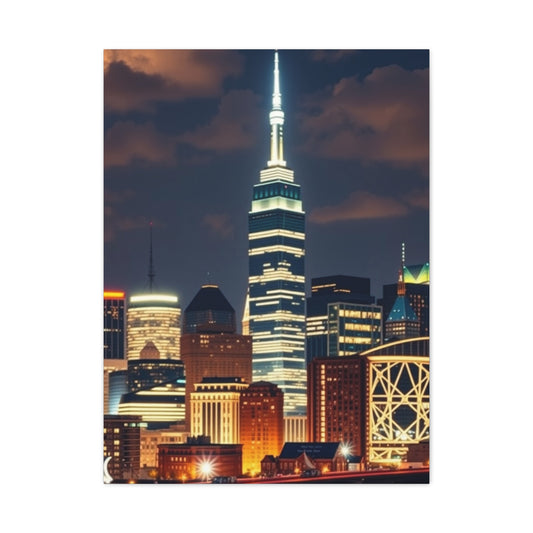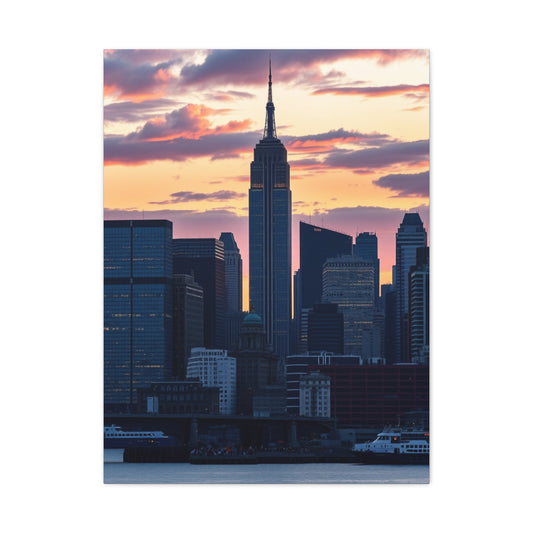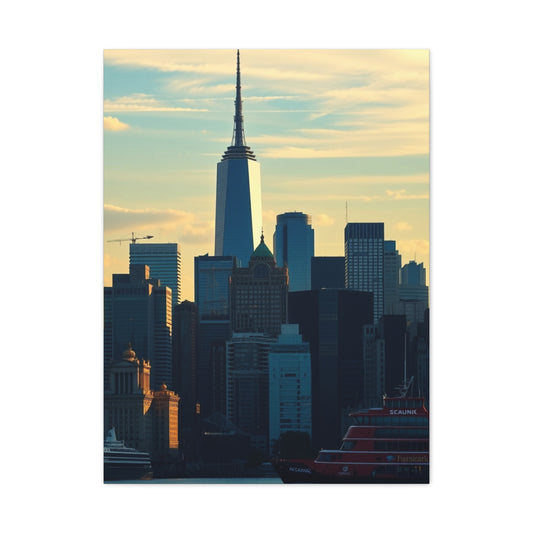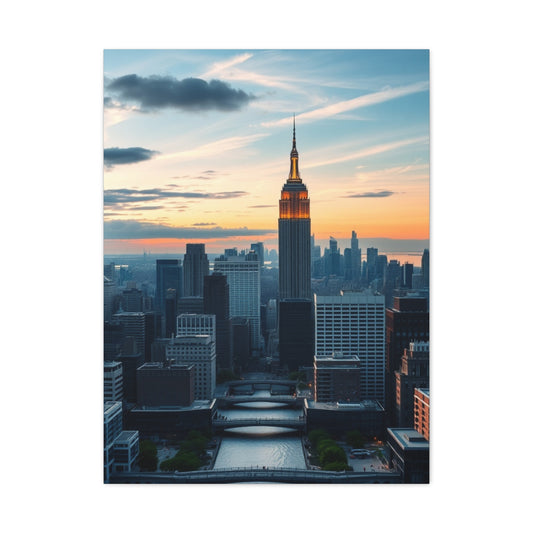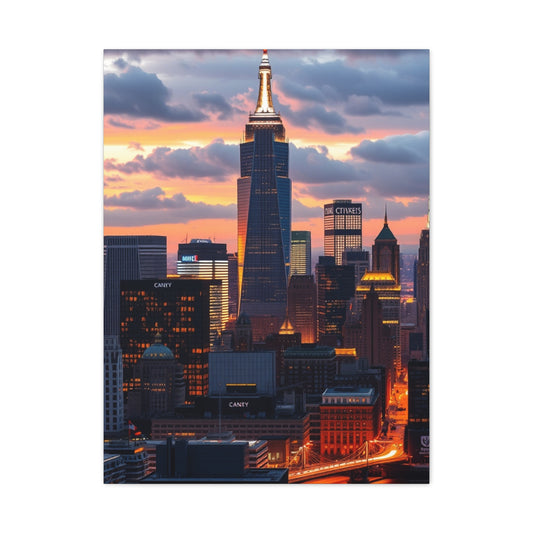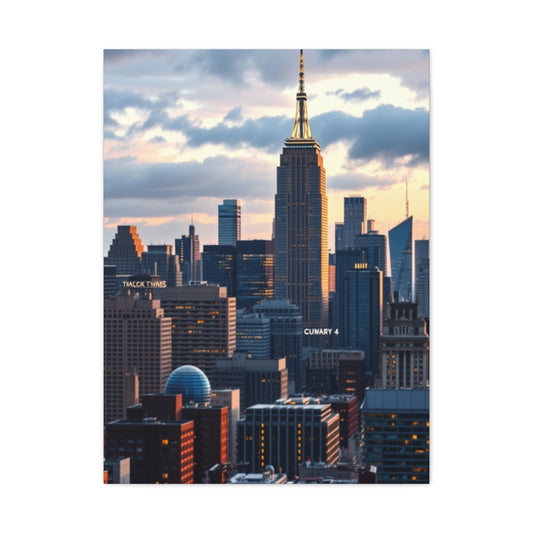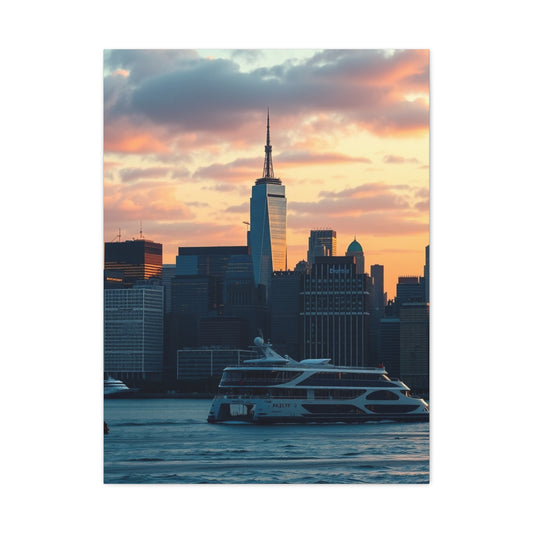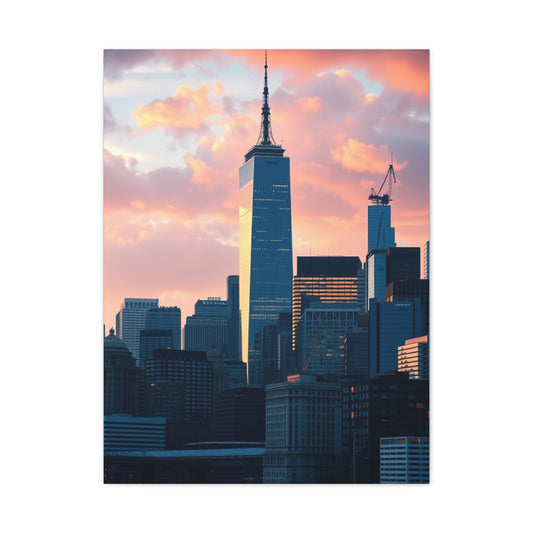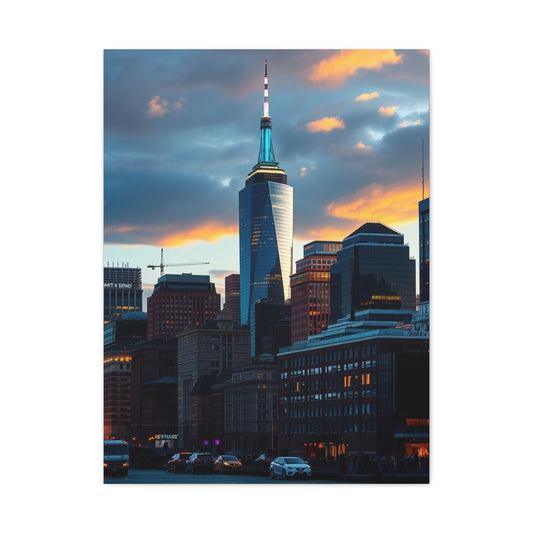Stunning Wall Art of New York Skyline at Night
Cityscapes at night possess a rare enchantment that seems to merge light, architecture, and atmosphere into one seamless composition. The darkness provides a dramatic backdrop, allowing glowing skyscrapers, flickering neon signs, and the muted silhouettes of bridges to create an ever-changing tapestry of urban life. When captured as photo art, these scenes become more than simple documentation; they embody the pulse of cities, their vibrancy, and their timeless allure. One particularly captivating example is the New York skyline at night, immortalized by Steve Rea in a striking 12”x16” Classic Silver Metal Print. Taken from the rooftop café of the Rockefeller Tower with nothing more than an iPhone, this image demonstrates how modern technology, artistry, and personal vision can converge to produce something that resonates deeply.
This photograph is more than a view of illuminated skyscrapers—it is a testament to the accessibility of art in the digital age, where anyone with an eye for beauty can transform an ordinary device into a tool for storytelling. Rea’s image is part of a broader series of nighttime cityscapes he has captured in places such as Quebec City, Victoria, Houston, Paris, and Tokyo, each one reflecting the individuality of a city while tying them together through the universal language of light and shadow. This interplay of locations and methods transforms a simple photograph into a cultural narrative, where every glowing window hints at countless untold stories.
Historical Background
To appreciate the power of a nighttime cityscape in wall art, it is essential to understand its origins. Urban photography, particularly night photography, dates back to the early 19th century when pioneers experimented with long exposure techniques. Back then, the challenge lay in balancing dim natural light with the technological limitations of cameras and chemical processes. Early images of cities at dusk or night required hours of exposure, often resulting in blurred or ghostly impressions of movement. Yet these imperfections added a surreal quality, making them precursors to the dreamy, cinematic cityscape photography we know today.
New York has been one of the most photographed cities in history, often regarded as a muse for countless artists. Its skyline, with iconic landmarks such as the Empire State Building, Chrysler Building, and One World Trade Center, symbolizes progress, resilience, and aspiration. By the early 20th century, photographers like Alfred Stieglitz and Berenice Abbott began capturing the metropolis with bold contrasts, exploring how artificial light reshaped architectural forms. With the invention of faster film and portable cameras, night photography flourished, allowing artists to experiment with perspectives that mirrored the pace of urban expansion.
The tradition of printing photography on metal surfaces also has its lineage. Photogravure and other techniques in the 19th century hinted at the durability and brilliance of metallic finishes, but it was not until recent decades that brushed aluminum and dye-sublimation processes created a modern renaissance in metal wall art. By printing directly onto aluminum panels, images gain both permanence and depth, echoing the industrial foundations of the cities they portray. Steve Rea’s Classic Silver Metal Print continues this tradition, blending historical aspirations with contemporary innovation.
Core Concepts and Foundations
At the heart of nighttime cityscape wall art lies a combination of three foundational elements: perspective, light, and material. Perspective dictates the visual story; whether viewed from the heights of Rockefeller Tower, the edges of Brooklyn, or the quiet solitude of a riverside promenade, each angle communicates a different narrative. In Rea’s photograph, the elevated vantage point invites viewers into a panoramic dreamscape where the city’s geometry unfolds beneath a cloak of night.
Light is equally central. Artificial illumination—whether from skyscraper windows, street lamps, or distant headlights—creates a mosaic that defines the essence of urban nights. Unlike daylight, which flattens surfaces with uniform brightness, nighttime lighting accentuates contrasts, shadows, and textures, adding an almost theatrical dimension to architecture. Steve’s use of minimal editing to adjust contrast, saturation, and shadows allows the skyline to retain its authenticity while revealing the subtleties of color gradation across the city’s horizon.
Finally, the choice of material transforms a photograph into enduring wall art. Metal prints, especially the Classic Silver variant, introduce a unique reflective property. Unlike traditional paper or canvas, brushed aluminum interacts with ambient light in the room, shifting its appearance depending on angle and illumination. Whites and low-saturation tones reveal the natural texture of the metal, giving the artwork a multidimensional presence. This interplay echoes the shimmering effect of actual city lights, making the artwork feel alive even when static on a wall.
Together, these foundational elements converge into a cohesive philosophy: nighttime cityscape wall art is not merely about capturing an image but about distilling the rhythm of a metropolis into a form that can be experienced anew with every glance.
Types and Categories
When exploring cityscape photography as wall art, particularly printed on metal, it becomes clear that the genre extends into several categories, each with its own expressive possibilities.
One category is the panoramic skyline, like the New York photograph, where vast city horizons unfold in a single sweeping view. This type emphasizes scale, balance, and the collective glow of countless lights. It evokes grandeur and awe, making it an ideal centerpiece for a gallery wall or a living room.
Another type is the architectural close-up, focusing on the unique contours of a specific building at night. Whether it’s the intricate spire of a cathedral illuminated against the sky or the sleek glass surfaces of a modern skyscraper reflecting neon, these works highlight the artistry of human construction within an urban landscape.
A third variation lies in the atmospheric street-level capture, where smaller details—cobblestone streets glistening with rain, reflections in puddles, or the blur of headlights—offer an intimate portrayal of city life. These scenes often feel cinematic, allowing the viewer to imagine themselves within the frame.
There is also the multi-city series, such as Steve Rea’s collection across global metropolises. These works not only document different skylines but also reveal the universal qualities of cities after dark: the vibrancy of Tokyo, the romance of Paris, the elegance of Quebec City. Together, such collections highlight cultural diversity while underlining humanity’s shared fascination with illuminated urban spaces.
Each of these categories finds new expression when rendered as wall art on metal. Panoramic skylines gain depth and shimmer on brushed aluminum, close-ups emphasize sharpness and contrast, and atmospheric street shots acquire a subtle reflective glow that mimics real-life lighting conditions.
Practical Applications
The appeal of nighttime cityscape wall art extends beyond private enjoyment; it has numerous practical applications in both personal and professional settings.
In homes, a Classic Silver Metal Print of a city skyline becomes a focal point that not only decorates a wall but also sparks conversations. It introduces sophistication to interiors, blending seamlessly with both modern minimalism and eclectic styles. The reflective properties of brushed aluminum allow the artwork to adapt to different lighting conditions in a living space, making it dynamic and interactive.
In professional environments, such as corporate offices, conference rooms, or hospitality venues, cityscape wall art carries symbolic weight. A New York skyline print might represent ambition, innovation, and global connectivity—qualities many organizations wish to embody. The durability of metal prints also ensures longevity, making them practical for high-traffic spaces where paper or canvas might fade or warp.
Nighttime cityscapes also play a role in personal storytelling. Travelers who capture their own images and print them on metal create deeply personal heirlooms. Imagine a gallery wall composed of one’s journeys—Parisian boulevards, Tokyo’s neon labyrinths, or Houston’s illuminated skyline—all unified through the medium of brushed aluminum. Each print becomes a chapter in a larger narrative of exploration, memory, and artistic expression.
Furthermore, educational and cultural institutions can use cityscape wall art as a tool for engaging audiences. Exhibitions featuring nighttime skylines can foster discussions about architecture, urban development, cultural symbolism, and technological progress. The medium of metal printing, with its durability and visual impact, ensures these exhibitions remain striking and relevant.
Techniques and Methods
The creation of nighttime cityscape wall art requires both artistic intuition and technical understanding. Although Steve Rea’s photograph of the New York skyline was captured with a simple iPhone, the methods he applied illustrate how accessible the process can be when executed thoughtfully. Photography at night is essentially a dialogue between light and exposure, and the techniques used can drastically alter the outcome.
One fundamental method is mastering exposure settings. Long exposures, often extending several seconds, allow cameras to gather the faint light of distant buildings, glowing signs, and reflections across glass and water surfaces. These longer shutter speeds create a balanced luminosity that mimics the human eye’s adaptability to low light. Without this approach, the final image may appear underexposed or noisy. Photographers also employ tripods to eliminate motion blur, ensuring that architectural lines remain sharp against the softness of the night sky.
Another technique lies in the manipulation of focus. Autofocus systems struggle in low-light conditions, so manual focus becomes indispensable. By adjusting focus on the brightest elements within the frame, such as illuminated towers or streetlamps, photographers achieve crisp definition while preserving atmospheric depth. This method is particularly relevant when working with cityscapes where the interplay of sharp structures and ambient glow defines the essence of the scene.
Color management also plays a crucial role. Night photography is saturated with varying light temperatures, from the cool bluish hues of LED streetlights to the warm amber tones of incandescent bulbs. By adjusting white balance either in-camera or during post-processing, artists can create harmony or deliberate contrasts between these tones. Rea’s subtle editing of saturation and shadows demonstrates how even minimal intervention can enhance mood without distorting authenticity.
The printing method further shapes the final artwork. Classic Silver Metal Prints rely on direct printing onto brushed aluminum, allowing whites and pale areas to reveal the natural metallic surface. This technique produces a shimmer that emulates the twinkling of city lights, a quality unattainable with paper or canvas. Artists often choose this medium precisely because it mirrors the luminous energy of cities after dark. Dye-sublimation, used in HD Metal Prints, infuses ink into a protective coating, achieving high gloss and vibrant colors. Each method offers its own visual language, and selecting the right one ensures that the artwork resonates with its intended atmosphere.
Challenges and Common Mistakes
Despite the allure of nighttime cityscape photography, it presents distinct challenges that can frustrate even seasoned photographers. One of the most frequent mistakes is underestimating the difficulty of exposure. The balance between highlights and shadows can easily tip toward overexposure of bright lights or underexposure of darker areas. This imbalance often results in images that lack depth, flattening the visual narrative of the city.
Another common pitfall lies in noise, which manifests as unwanted graininess in low-light photographs. Without proper adjustments to ISO sensitivity or the use of long-exposure techniques, the digital sensor struggles to render clarity. Many beginners increase ISO excessively, introducing distortion that undermines the sharpness of architectural lines. The key lies in moderation—pairing lower ISO settings with longer exposures while relying on stabilization tools such as tripods or even handheld gimbals.
Composition errors also plague nighttime photography. With the allure of glowing skylines, photographers sometimes overlook foreground elements or framing considerations. A skyline photograph without an anchor point, such as a bridge, river, or rooftop edge, can appear flat or disjointed. By integrating foreground interest, artists create layers that invite viewers to step into the scene.
Another overlooked issue is editing. While post-processing is vital to enhance contrast and color, over-editing can strip images of authenticity. Excessive saturation, exaggerated sharpening, or aggressive shadow lifting can transform a natural cityscape into something artificial. The beauty of night lies in its subtle gradations, and respecting those subtleties is crucial.
When transferring photographs onto wall art mediums such as metal, sizing mistakes also occur. A panoramic cityscape printed too small loses its immersive effect, while oversized prints without sufficient resolution appear pixelated. Choosing appropriate dimensions relative to both the image quality and the intended display environment ensures the artwork maintains its integrity.
Trends and Future Outlook
The evolution of nighttime cityscape wall art reflects broader cultural and technological shifts. One emerging trend is the democratization of photography. With advancements in smartphone technology, as demonstrated by Steve Rea’s iPhone capture, more individuals can produce gallery-worthy images without specialized equipment. Computational photography now allows devices to stack multiple exposures, reduce noise, and enhance dynamic range automatically, making professional-level results accessible to anyone with curiosity and patience.
Another trend is the growing popularity of metal prints as a medium for contemporary interiors. Their durability, sleek appearance, and ability to reflect ambient light align with modern design aesthetics. As sustainability gains importance, aluminum printing also appeals due to its recyclability and long lifespan compared to traditional materials. Future innovations may further refine eco-friendly processes, reducing environmental impact while enhancing visual quality.
Personalization is also shaping the future of cityscape wall art. Increasingly, individuals seek to print their own travel photography, transforming personal memories into enduring art pieces. Rather than purchasing generic stock images, people are creating collections that reflect their unique journeys, whether wandering through the streets of Tokyo or standing atop New York’s Rockefeller Tower. This shift speaks to a desire for authenticity and individuality in home and office décor.
On a global scale, virtual and augmented reality technologies are beginning to influence photographic art. Imagine wall art integrated with AR, where a viewer can scan the print with a device and watch a time-lapse of the city lights coming to life. Such hybrid experiences blur the boundaries between traditional wall art and digital storytelling, expanding the possibilities for future cityscape displays.
Cultural trends also play a role. As urbanization continues, cities are becoming the dominant landscapes of human life, and nighttime skylines symbolize modern identity. Wall art capturing these environments serves not only as decoration but also as reflection, offering viewers a chance to contemplate the energy, beauty, and complexity of contemporary existence.
Expert Insights
Artists, photographers, and printmakers offer valuable perspectives that illuminate why nighttime cityscapes remain so compelling as wall art. Many emphasize the narrative power of light in shaping emotions. Architectural photographer Jonathan Becker, for instance, has described city lights as “the modern campfire,” a collective glow that gathers people and tells unspoken stories. This insight explains why illuminated skylines resonate so strongly—they are visual metaphors for human community and progress.
Print specialists highlight the unique synergy between metal surfaces and night photography. The reflective texture of brushed aluminum interacts dynamically with light in a room, changing the artwork’s mood throughout the day. Curators often describe this as a “living surface,” where the art does not remain static but evolves with its environment. For collectors, this quality enhances longevity, as the piece never feels stale or repetitive.
Travel photographers also stress the emotional dimension. Steve Rea’s series across cities like Paris, Tokyo, and Quebec underscores how each location, while distinct, shares a universal rhythm at night. This interconnectedness resonates with viewers who have walked those same streets, creating personal connections to the artwork. Experts agree that the most successful cityscape wall art balances technical precision with emotional resonance, inviting viewers to feel both awe and intimacy.
Finally, design professionals recommend the strategic placement of cityscape prints within interiors. A panoramic skyline above a sofa, for instance, anchors the living space with grandeur, while smaller prints clustered in a hallway create a storytelling sequence. Lighting design further amplifies the impact; directional spotlights or soft ambient fixtures can enhance the reflective shimmer of metal prints, replicating the glow of actual city lights.
As expert voices suggest, the enduring appeal of nighttime cityscapes lies not only in their visual beauty but also in their symbolic weight. They embody ambition, memory, and connection, transforming ordinary walls into gateways to extraordinary vistas.
Emerging Trends in Wall Art
The world of wall art has always been a reflection of cultural evolution, shifting design philosophies, and the changing ways in which people seek to personalize their surroundings. In recent years, the transformation of wall art has accelerated dramatically, fueled by technological innovation, global connectivity, and a renewed appreciation for creativity in everyday spaces. No longer limited to traditional paintings or framed prints, wall art today encompasses a wide spectrum of mediums, from metal and acrylic to digital and interactive displays. These emerging trends illustrate how art has become more accessible, personalized, and integrated into modern living.
One significant trend is the rising popularity of metal wall art, particularly brushed aluminum and high-gloss finishes that interact with light. The reflective surface offers a sense of dynamism, shifting its appearance depending on the viewing angle and illumination in the room. This adaptability resonates with contemporary design principles, where versatility and movement are highly valued. Pieces such as panoramic skylines or abstract compositions gain additional vitality when printed on such materials, transforming static imagery into a living experience.
Another trend is the incorporation of sustainability into wall art. Conscious consumers increasingly seek artworks that use eco-friendly materials, non-toxic inks, and recyclable substrates. Artists and printing companies are responding with innovations that reduce environmental footprints while maintaining visual quality. Bamboo-based frames, recycled aluminum, and water-based printing processes exemplify how the art industry is aligning with broader ecological awareness.
Personalization has also emerged as a dominant theme. Rather than relying solely on mass-produced décor, individuals are commissioning custom pieces or transforming their own photography into wall art. This movement reflects a desire for uniqueness and authenticity, with travelers, for instance, turning their personal cityscape photos into gallery-worthy metal prints. These personalized works become more than decoration—they embody memory, identity, and personal narrative.
Digital integration is shaping the future as well. Interactive wall art, powered by augmented reality or embedded QR codes, allows viewers to engage with artworks in multidimensional ways. A photograph of a skyline can be scanned to reveal a time-lapse of the city lights or an artist’s commentary. Such innovations are blurring the line between traditional art and multimedia experiences, offering new forms of engagement.
Minimalist trends are also influencing wall art. Clean lines, muted palettes, and geometric forms have gained prominence, aligning with modern architectural interiors. Yet, at the opposite end, maximalist wall art—bold colors, intricate patterns, and large-scale installations—has also found an audience, particularly among those seeking statement pieces that dominate a room. The coexistence of minimalism and maximalism highlights the diversity of preferences and the flexibility of wall art in accommodating varied tastes.
Cultural fusion remains another defining trend. Globalization has brought artistic influences from around the world into homes and workplaces. Japanese woodblock-inspired prints, Moroccan geometric motifs, Scandinavian simplicity, and New York-inspired skylines often coexist in curated spaces, reflecting the interconnectedness of contemporary culture. This blending of aesthetics underscores wall art’s role as both personal expression and cultural dialogue.
Step-by-Step Guides
Creating wall art, whether for personal enjoyment or professional display, involves both creative vision and practical execution. A structured approach helps individuals translate inspiration into tangible pieces that enhance their environments. Below is a step-by-step framework that can guide anyone, from novice enthusiasts to seasoned artists, through the process of creating meaningful wall art.
Step One: Define the Concept
Every successful piece of wall art begins with a clear concept. This involves identifying the message or feeling one wants to convey. For example, a nighttime cityscape might symbolize ambition and modernity, while a serene landscape could represent tranquility. Defining the purpose ensures that the artwork resonates with its intended audience and complements the space where it will be displayed.
Step Two: Choose the Medium
The choice of medium greatly influences the character of wall art. Traditional canvas offers a timeless and textured quality, while metal prints create a sleek, contemporary effect. Acrylic provides depth and vibrancy, whereas framed paper prints offer a classic aesthetic. The medium should align with both the subject matter and the design context of the room. For instance, urban skylines often benefit from the reflective properties of brushed aluminum, while softer portraits might flourish on matte canvas.
Step Three: Capture or Select the Image
If creating wall art from photography, capturing the right image is critical. Composition, lighting, and perspective all shape the outcome. For cityscapes, elevated vantage points provide expansive views, while street-level shots reveal atmosphere and detail. If using existing artwork or digital designs, selection should be deliberate, ensuring the piece aligns with the concept defined earlier. When selecting personal photography, one should consider emotional value as much as visual appeal.
Step Four: Enhance Through Editing
Post-processing or editing refines the raw material into a polished piece. Adjustments to contrast, brightness, saturation, and sharpness can elevate an image while preserving its authenticity. Subtlety is key; over-editing risks distorting the natural beauty of the subject. Specialized software allows for corrections such as noise reduction in nighttime images or alignment adjustments for architectural shots. This step ensures that the artwork achieves both technical precision and artistic resonance.
Step Five: Select Dimensions and Format
The scale of wall art significantly impacts its effect within a space. A large panoramic piece can dominate a living room wall, becoming the focal point of the décor, while a smaller print may work better in intimate settings like hallways or study nooks. Proportions also matter—wide cityscapes may demand rectangular frames, whereas abstract designs could thrive in square or circular formats. Thoughtful consideration of size and format ensures harmony between the artwork and its environment.
Step Six: Print and Production
Choosing a reliable printing process is essential to translate digital images into physical art. Metal printing, for instance, involves either direct printing onto aluminum or dye-sublimation into a protective coating. Each technique has its own aesthetic advantages. Quality materials and precise craftsmanship are necessary to preserve the integrity of the artwork and ensure longevity. Collaborating with reputable printers guarantees that the final product meets professional standards.
Step Seven: Frame or Mount
While some wall art, such as metal or acrylic prints, can be displayed without frames, others benefit from framing or mounting. Frames can add character, from rustic wooden borders to sleek modern finishes. Mounting options, such as floating panels or gallery wraps, influence how the piece interacts with the wall and the surrounding décor. The decision should enhance, rather than distract from, the artwork itself.
Step Eight: Placement and Display
The location where wall art is displayed determines its impact. A statement piece above a fireplace draws attention, while a collection of smaller works in a hallway creates rhythm and continuity. Lighting also plays a crucial role. Directional spotlights can highlight details, while ambient lighting can soften the overall effect. Considering viewing angles and sightlines ensures that the artwork engages viewers naturally.
Step Nine: Preservation and Care
Wall art, regardless of medium, requires care to maintain its beauty over time. Dusting with non-abrasive cloths, avoiding direct sunlight, and controlling humidity are basic practices. Metal and acrylic prints are particularly durable, but they too benefit from mindful handling. For collectors, preserving authenticity also involves keeping records of origin, printing method, and artist details.
Step Ten: Continual Evolution
Wall art is not static; it reflects evolving tastes, experiences, and environments. Periodically refreshing or rotating artworks keeps interiors dynamic and engaging. Personal collections often grow organically, with each piece adding to a broader narrative of life, travel, and inspiration. Embracing this continual evolution ensures that wall art remains a living dialogue rather than a static decoration.
Cultural Significance of Wall Art
Wall art is far more than decoration; it is a reflection of cultural identity, human expression, and shared history. Across centuries, people have turned blank surfaces into canvases that carry meaning—whether through cave paintings, medieval frescoes, or modern digital murals. In today’s context, wall art continues to play the role of a cultural mirror, capturing the essence of societal values, technological achievements, and personal narratives.
Cityscape wall art, particularly nighttime skylines, speaks to the collective fascination with urban life. The illuminated towers of New York, the glowing streets of Paris, or the vibrant neon corridors of Tokyo are not only visual marvels but also metaphors for progress, ambition, and interconnectedness. When displayed on walls, these images resonate with viewers on multiple levels. They inspire dreams of travel, embody professional aspirations, or simply reflect admiration for human creativity.
Wall art also bridges cultural boundaries. A single home may display prints inspired by Eastern calligraphy, Scandinavian minimalism, and North American skylines, creating a tapestry of global influence. This intermingling of aesthetics reflects a world where borders are increasingly fluid, and identities are layered. Each piece of wall art becomes part of a broader dialogue between traditions, contemporary lifestyles, and personal stories.
Within public spaces, wall art functions as a collective memory. Murals in city centers or large-scale installations in corporate lobbies remind communities of their history and aspirations. When translated into private collections, these images bring fragments of that collective narrative into individual lives. The presence of such art on walls transforms ordinary rooms into spaces of contemplation, culture, and dialogue.
Transformative Power of Interior Spaces
The impact of wall art extends beyond cultural symbolism into the very fabric of interior environments. The right artwork can reshape a room, altering its atmosphere, energy, and purpose. A luminous skyline printed on brushed aluminum adds a sense of openness and grandeur to a compact apartment, while a series of abstract canvases can infuse vibrancy into a minimalist office.
Interior designers frequently emphasize that wall art is not an afterthought but an anchor for the entire aesthetic composition of a space. It can determine the palette of furniture, the placement of lighting, and even the flow of movement within a room. A striking panoramic cityscape above a sofa creates a focal point that orients the viewer’s gaze, while a carefully curated gallery wall in a hallway can transform a transitional space into an intimate gallery experience.
Wall art also influences mood. Calming landscapes, soft color palettes, and serene imagery promote relaxation in bedrooms and meditation areas. Conversely, bold city skylines, energetic abstract patterns, or vivid photography invigorate social spaces such as living rooms and dining areas. The reflective properties of metal wall art introduce an additional layer of dynamism, as the artwork subtly shifts its appearance with changes in light and perspective, mirroring the fluid rhythms of daily life.
Beyond aesthetics, wall art contributes to identity. In homes, it expresses individuality, reflecting the passions, travels, and creative sensibilities of its inhabitants. In workplaces, it communicates organizational values, whether through depictions of iconic skylines that symbolize ambition or abstract pieces that suggest innovation. By integrating wall art intentionally, spaces are transformed into environments that tell stories and foster deeper connections.
The Fusion of Technology and Art
Technological advancements have revolutionized both the creation and the experience of wall art. High-resolution digital photography, sophisticated editing tools, and advanced printing methods have expanded artistic possibilities. Where earlier generations relied on oil paints or lithographs, today’s artists and enthusiasts can transform smartphone captures into gallery-quality prints.
Metal printing technologies stand at the forefront of this fusion. Processes such as dye-sublimation infuse inks directly into protective coatings, producing images with exceptional vibrancy and durability. Direct printing onto brushed aluminum, as in Classic Silver Metal Prints, allows the texture of the metal to interact with the image, creating luminous highlights that echo the sparkle of city lights. Such innovations blur the line between traditional art and modern craftsmanship, offering collectors pieces that are both artistic and technological achievements.
Digital integration further extends the role of wall art. Augmented reality overlays allow viewers to interact with physical prints through their devices, unlocking hidden stories, animations, or background information. Museums and galleries are increasingly experimenting with hybrid exhibitions where static works are complemented by interactive digital layers. In homes, QR-enabled prints can connect viewers to time-lapse videos or artist commentaries, transforming static décor into a multi-sensory experience.
Three-dimensional printing is also influencing the field. Textured surfaces, layered reliefs, and sculptural wall panels push wall art beyond the two-dimensional plane, offering tactile engagement. Combined with lighting design, these works produce immersive environments where art and architecture merge seamlessly.
The convergence of technology and art demonstrates that wall art is not bound by tradition alone; it is an evolving practice that adapts to new tools while continuing to fulfill its timeless purpose of inspiring, provoking, and beautifying.
The Global Marketplace of Wall Art
The accessibility of wall art has expanded significantly through digital platforms, transforming the marketplace into a truly global phenomenon. Online galleries and print-on-demand services enable artists to reach international audiences, while customers can explore and purchase works from anywhere in the world. This democratization of art distribution ensures that creativity is no longer confined to elite circles but available to anyone with an internet connection.
Travel-inspired wall art is particularly popular in this context. Individuals who capture their own cityscape photographs during journeys can upload them to printing services, customizing size, medium, and finish before having them delivered to their doorstep. This personalization creates a seamless connection between personal experiences and professional-quality products.
Social media also plays a pivotal role in shaping tastes and trends. Platforms such as Instagram and Pinterest have become virtual galleries, where emerging styles gain visibility and inspire décor decisions. The viral spread of visual inspiration accelerates the adoption of new styles, whether it is minimalist line drawings, bold murals, or shimmering skylines printed on aluminum.
At the same time, the global marketplace fosters diversity. Regional styles gain international recognition, from African tribal patterns to Scandinavian minimalism, enriching the visual vocabulary of wall art. This cross-pollination of influences ensures that contemporary collections often reflect a blend of local heritage and global dialogue.
Economic factors further highlight the role of wall art in modern lifestyles. Affordable print-on-demand options make art accessible to wider audiences, while limited edition prints and original works cater to collectors seeking exclusivity. This spectrum of affordability ensures that wall art can occupy spaces across all social and economic tiers, reinforcing its role as both personal expression and cultural commodity.
The Enduring Value of Artistic Expression
Amid shifting technologies and evolving trends, one truth remains constant: wall art endures because it satisfies a fundamental human need for expression. Walls are more than barriers; they are canvases waiting to be inscribed with meaning. Whether through ancient cave markings, medieval tapestries, or modern aluminum prints, people have always sought to imprint their surroundings with visual narratives.
Nighttime cityscapes epitomize this desire in the contemporary era. They capture the wonder of urban environments, blending human achievement with natural beauty. Their luminous compositions remind viewers of ambition, resilience, and the shared rhythms of modern life. By translating such images into wall art, artists and collectors create pieces that are both personal keepsakes and universal symbols.
Art’s enduring value also lies in its emotional resonance. A skyline photograph may recall a cherished journey, a personal milestone, or an aspiration yet to be achieved. A landscape may evoke serenity, while an abstract piece may stimulate curiosity. These emotions enrich daily life, providing both comfort and inspiration. In this way, wall art functions not only as décor but as a companion to human experience.
Conclusion
The journey through the world of wall art reveals a landscape as dynamic as the cities it depicts. From the cultural significance of illuminated skylines to the transformative impact of art within interiors, from the technological innovations of metal printing to the global accessibility of digital marketplaces, wall art has evolved into a medium that bridges tradition and modernity.
Emerging trends demonstrate a growing emphasis on personalization, sustainability, and digital integration, while step-by-step approaches empower individuals to transform inspiration into tangible pieces that enrich their lives. Experts highlight how light, material, and placement can elevate the impact of wall art, while global markets ensure that diverse styles reach audiences worldwide.
Yet, beneath all these transformations lies a timeless truth: wall art is an expression of humanity’s need to create, to remember, and to connect. Whether through Steve Rea’s photograph of the New York skyline, a handcrafted mural, or a digital installation, wall art endures as a testament to imagination and identity. It turns blank spaces into meaningful experiences, offering viewers not only beauty but also a reflection of who they are and who they aspire to become.
As walls continue to bear the imprints of culture and creativity, wall art will remain both an anchor and a frontier—a timeless reminder that human expression, like the city lights at night, will never cease to shine.

